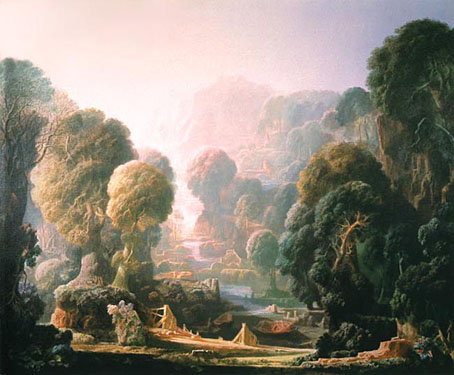
Sunrise in a Valley (1974).
It’s difficult to say whether the work of Harold Hitchcock (born 1914) is rarely seen in his native country because of those British art critics who’ve often regarded fantastic or sacred themes with suspicion—or whether it’s merely because people find his work to be bad. Sometimes the latter accusation appears to be a disguise for the former belief, especially among those who follow the pack rather than drawing their own conclusions. At times the English Channel has acted as an aesthetic as well as a physical barrier. British art never quite got to grips with Surrealism, despite the best efforts of Roland Penrose and others, while Symbolism was almost exclusively a Continental movement whose existence was largely expunged from later art histories; the 1959 Penguin Dictionary of Art and Artists, for instance, has entries for minor groupings such as the Hudson River School and the Nazarenes, but no entry at all for Symbolism. Fantasy was allowable in illustration but not elsewhere; no wonder Mervyn Peake took up writing.
So much for polemic. Hitchcock’s work comprises very detailed landscapes that present a Claude Lorraine-like approach to light with more Modernist forays reminiscent of Expressionist painters such as Franz Marc. His fanciful works remind me of his Surrealist contemporary Leonora Carrington, with their creation of a self-contained, often naive, private world. Hitchcock lives in South Devon and was still active three years ago when the BBC reported his 90th birthday. The American exhibition mentioned in that news story took place at the Phillips Gallery, Carmel, CA and their site has three pages of (rather blurred) examples of his luminous work.
Update: The official Harold Hitchcock site
• Harold Hitchcock by Leonard Hitchcock
• Catching the Light by Emmanuel Williams
Elsewhere on { feuilleton }
• The fantastic art archive
